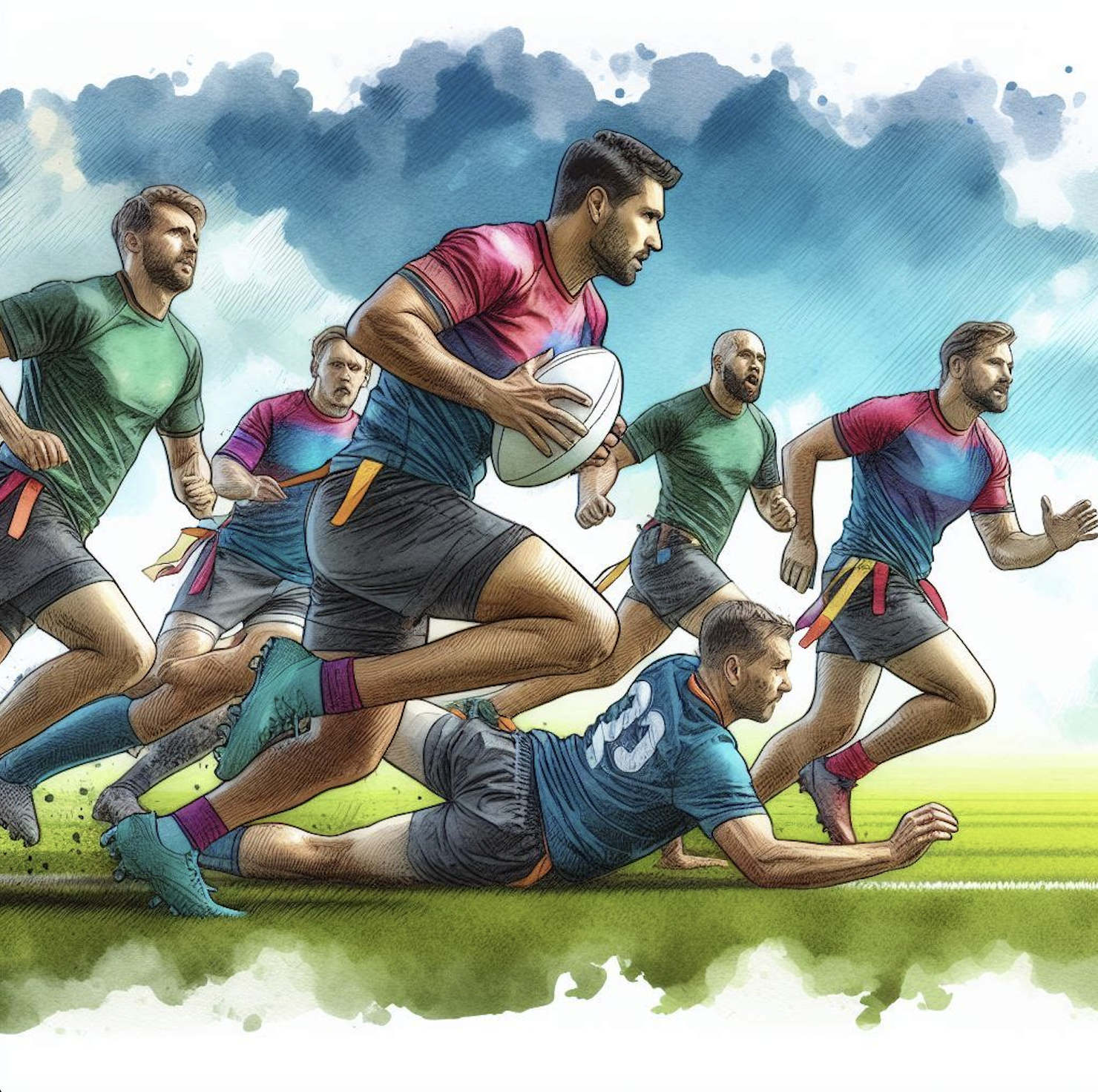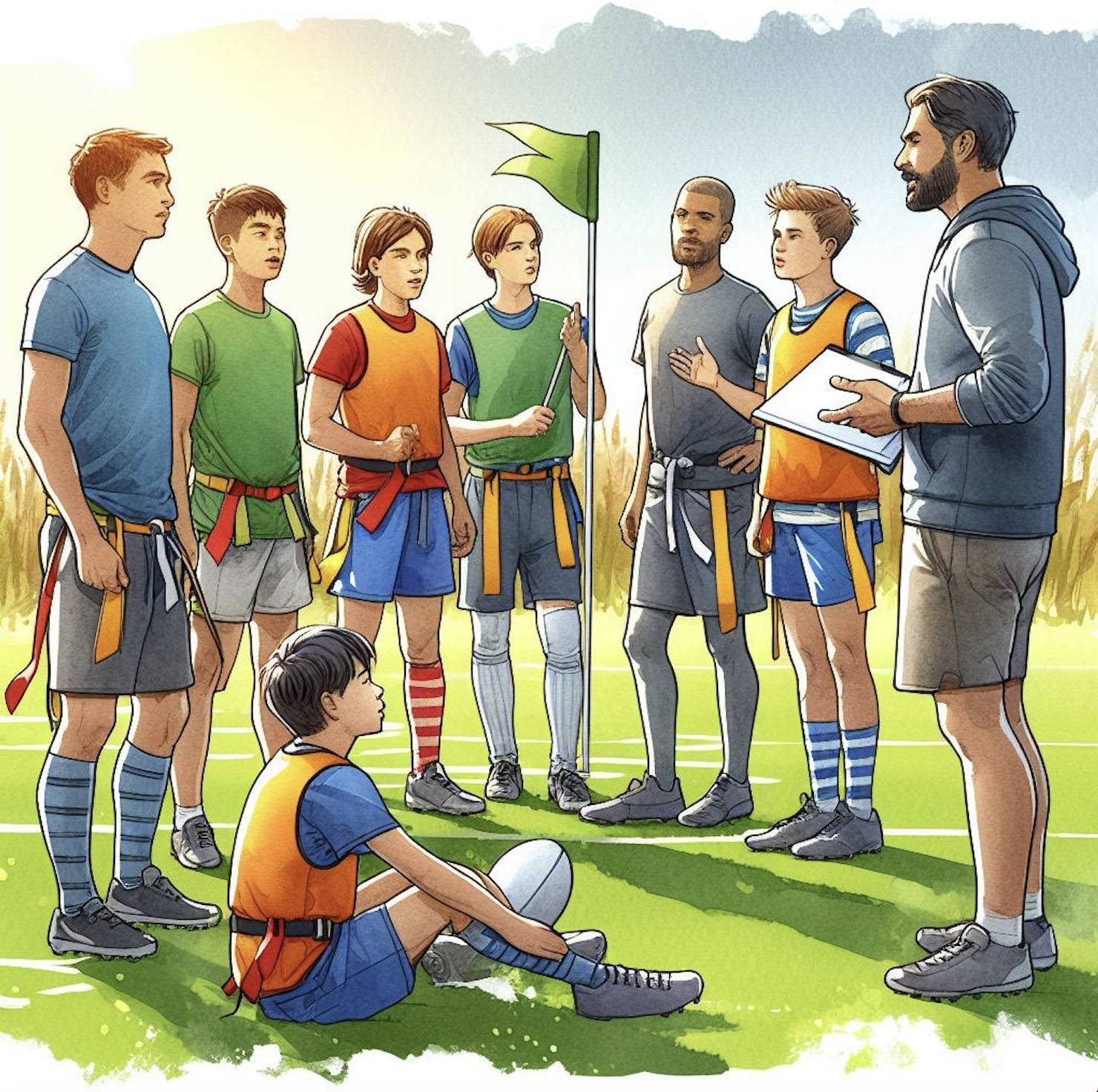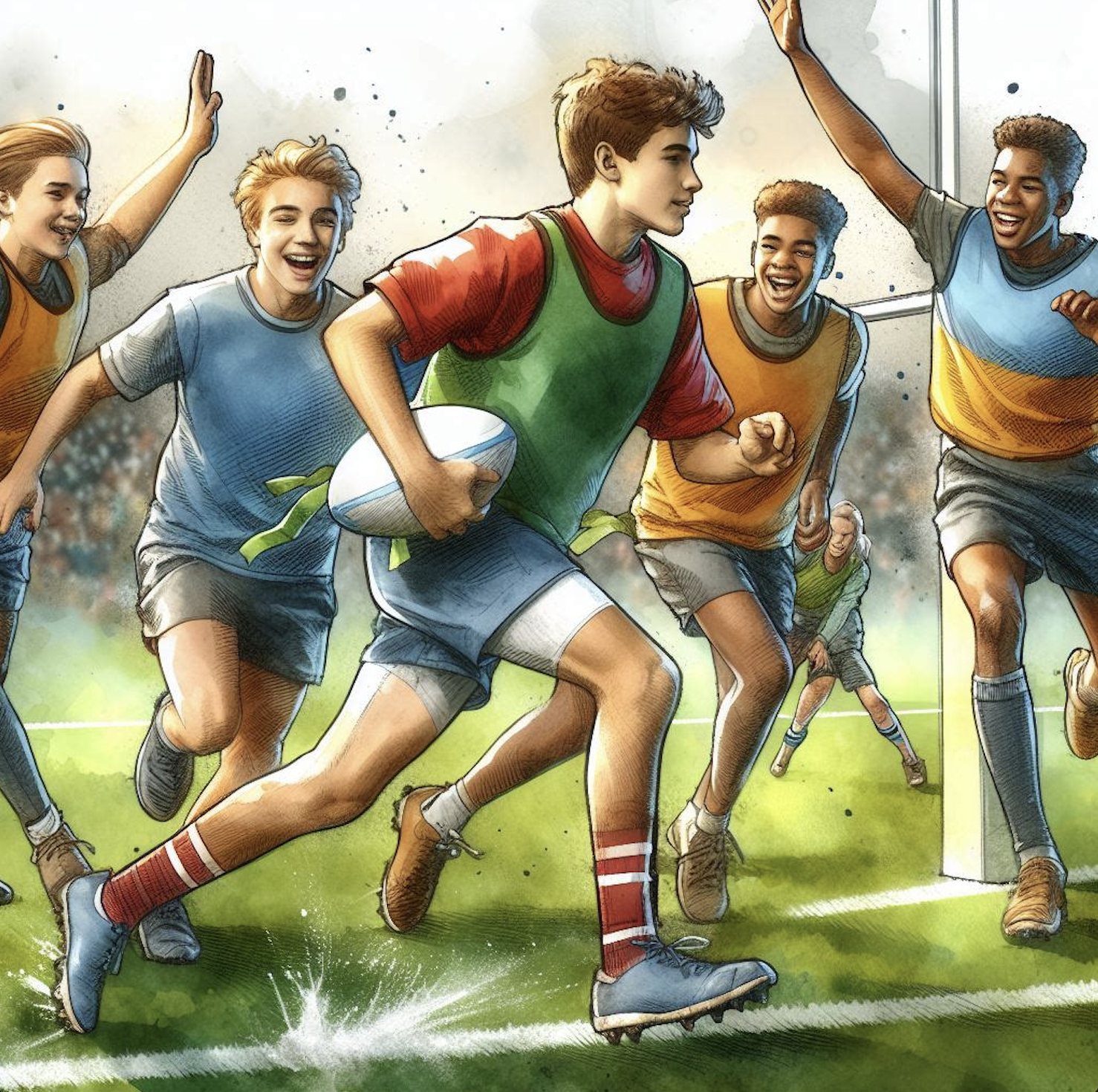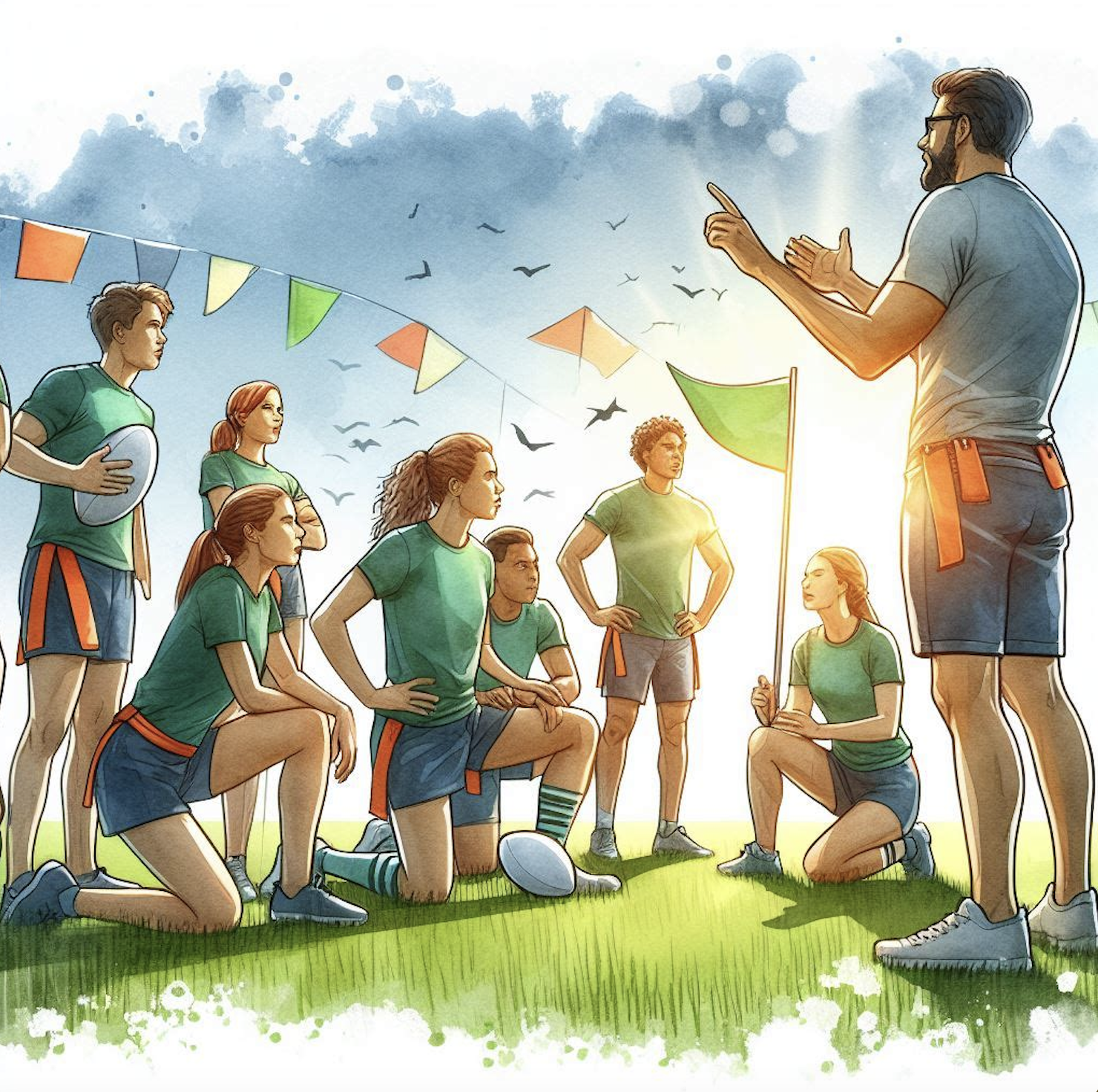Imagine a sunny afternoon at a local park. Children and adults alike gather, their eyes alight with anticipation. The grassy field awaits, marked with vibrant cones and painted lines. The atmosphere buzzes with excitement. What brings them all together?
Tag Rugby
It's a dynamic and exhilarating sport that combines the thrill of rugby with the finesse of football.

What is Tag Rugby?
The Essence of Tag Rugby
Tag Rugby is a dynamic and exhilarating adaptation of traditional rugby. It bridges the gap between full-contact rugby and touch rugby, offering a thrilling experience without the bone-crunching tackles. Let’s break it down:
- Non-Contact Form: Unlike regular rugby, where collisions are part of the game, tag rugby replaces tackling with the pulling of a tag. Players wear adjustable belts with two Velcro tags – one on each hip. When an opponent successfully removes a tag, it signifies a “tackle”.
- Simplified Rules: Tag rugby simplifies the game, making it accessible to beginners and seasoned players alike. The focus shifts from brute force to agility, teamwork, and strategic play.
Skill Development and Inclusivity
Tag Rugby serves as a powerful tool for skill development and inclusivity:
- Skill Acquisition: Whether you’re a seasoned player or a novice, tag rugby hones passing accuracy, running technique, catching skills, and defensive awareness. It’s a laboratory for refining the fundamentals.
- Inclusive Environment: Tag Rugby welcomes players of all ages, genders, and abilities. It fosters camaraderie and encourages participation without intimidation.
Safety and Physical Literacy
Safety is paramount in any form of rugby. While tag rugby significantly reduces the risk of injury compared to full-contact rugby, players must still understand the game’s fundamentals. Here’s what you need to know:
Field Dimensions and Equipment
- Field Size: Tag rugby adapts to various spaces—grass fields, parking lots, or gymnasiums. A recommended field size is no longer than 60 meters in length and 35 meters in width. Adjust the width based on the number of players per team (approximately 5 meters per player).
- Essential Equipment:
- The Ball: Use a standard rugby ball. Different sizes may suit various age groups.
- Field Markers: Cones or painted lines clearly define the sidelines, halfway line, and scoring areas.
- Footwear: Players should wear appropriate shoes for the playing surface, adhering to facility rules (especially regarding boots/cleats).
- Tag Positioning: Tags must be worn on each hip, unobstructed. Players attach both tags before participating in play.
Player Configuration and Substitutions
- Team Size: Tag rugby typically features 5 players per side. While more players can participate, fewer players mean more opportunities for each individual to engage in all aspects of the game.
- Rolling Substitutions: Players can re-enter during stoppages, maintaining a dynamic flow.

Tag Rugby Rules and How to Play
1. Overview
- Tag Rugby is a non-tackle version of rugby.
- Played in two teams, usually with 5 to 7 players per team.
- The objective is to score tries by grounding the ball over the opponent’s try line.
2. Field Dimensions
- The field dimensions are generally 70 meters by 45 meters.
3. Gameplay Basics
- Seven players from each team are allowed on the field at a time.
- The attacking team has six plays or tags to try to score a try or advance the ball downfield.
- Tries are worth one point, and there are no conversions.
4. Tagging
- Only the player with the ball can be tagged.
- A tag is simply the removal by a defender of one of the two ribbons from the ball carrier.
- Ball carriers can run or dodge potential taggers but cannot fend them off, spin around, or guard their ribbons.
5. Scoring
- Ground the ball over the opponent’s try line to score a try.
- The team with the most tries at the end of the game wins.
6. Recommended Ball Size
- For players under 14 years old, the recommended ball size is Size 4.

The Flow of Play
Let’s step onto the field and explore how a tag rugby match unfolds:
- Kick-off: The game begins with a kick-off. The team without possession kicks the ball to the opponents.
- Passing & Running: Players pass the ball laterally or forward. Running with the ball requires agility, quick decision-making, and spatial awareness.
- Tag Pulls: Instead of tackles, defenders aim to pull off their opponent’s tags. A successful tag pull signifies a “tackle”, and the ball carrier must stop immediately.
- Scoring: Teams score by crossing the opponent’s try line (similar to regular rugby). The try area should be at least 5 meters deep.
- Turnovers & Possession: If a tag is pulled or the ball is dropped, possession changes hands. Quick transitions keep the game dynamic.
- Teamwork & Strategy: Effective communication, precise passing, and strategic positioning are crucial for success.
Benefits of Tag Rugby
Let’s explore the benefits of playing Tag Rugby from various perspectives:
1. Individual Benefits:
- Physical Fitness: Tag Rugby involves running, dodging, and quick movements, which contribute to cardiovascular fitness, agility, and endurance.
- Improved Coordination: Players develop hand-eye coordination, balance, and spatial awareness as they pass the ball and evade opponents.
- Social Interaction: Tag Rugby fosters social connections, teamwork, and camaraderie. It provides an opportunity to meet new people and build friendships.
- Stress Relief: Engaging in physical activity releases endorphins, reducing stress and promoting mental well-being.
- Skill Development: Players enhance their passing, catching, and decision-making skills.
2. Team Benefits:
- Collaboration: Tag Rugby requires effective communication and cooperation among team members. Players learn to work together toward a common goal.
- Strategy and Tactics: Teams strategize to create openings, exploit weaknesses, and score tries. This encourages critical thinking and adaptability.
- Unity and Trust: Trusting teammates to make the right decisions builds team cohesion and unity.
- Leadership Opportunities: Players can take on leadership roles, motivating and guiding their team during matches.
3. Community and Societal Benefits:
- Inclusivity: Tag Rugby is accessible to people of all ages, genders, and abilities. It promotes diversity and inclusivity within communities.
- Local Engagement: Community-based leagues and events encourage participation, bringing people together and strengthening neighbourhood bonds.
- Health Promotion: By encouraging physical activity, Tag Rugby contributes to overall community health.
- Youth Development: Introducing Tag Rugby to schools and youth programs instils values like discipline, respect, and fair play.
- Reduced Social Isolation: Community sports foster connections, combat loneliness, and create a sense of belonging.
In summary, Tag Rugby offers a holistic package of physical, mental, and social benefits, making it an excellent choice for individuals, teams, and society at large.
Conclusion
Tag rugby transcends mere recreation; it’s a vibrant fusion of athleticism, strategy, and camaraderie. So next time you step onto that grassy field, Velcro tags fluttering, remember that you’re part of a legacy – a legacy that celebrates rugby’s spirit without the bone-crushing tackles.
Whether you’re a curious beginner or a seasoned pro, Tag rugby invites you to run, pass, and score. It’s a game where agility meets camaraderie, and where every sprint carries the echoes of rugby’s storied past.
So, grab your tags, lace up your boots, and let the game begin. 🏟️














Discussion